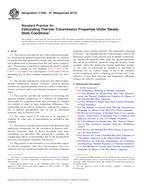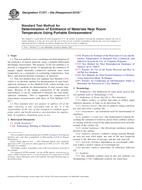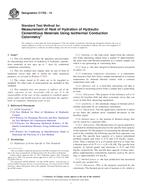Potrebujeme váš súhlas na využitie jednotlivých dát, aby sa vám okrem iného mohli ukazovať informácie týkajúce sa vašich záujmov. Súhlas udelíte kliknutím na tlačidlo „OK“.
ASTM C1045-07(2013)
Standard Practice for Calculating Thermal Transmission Properties Under Steady-State Conditions
Automaticky preložený názov:
Štandardné praktiky pre výpočet tepelných vlastností prenosu podľa ustálených podmienkach
NORMA vydaná dňa 1.9.2013
Informácie o norme:
Označenie normy: ASTM C1045-07(2013)
Poznámka: NEPLATNÁ
Dátum vydania normy: 1.9.2013
Kód tovaru: NS-9184
Počet strán: 13
Približná hmotnosť: 39 g (0.09 libier)
Krajina: Americká technická norma
Kategória: Technické normy ASTM
Kategórie - podobné normy:
Anotácia textu normy ASTM C1045-07(2013) :
Keywords:
calculation, thermal conductance, thermal conductivity, thermal properties, thermal resistance, thermal resistivity, thermal transmission, ICS Number Code 17.200.10 (Heat. Calorimetry)
Doplňujúce informácie
| Significance and Use | ||||||||||||||||||||||||||
|
4.1 ASTM thermal test method descriptions are complex because of added apparatus details necessary to ensure accurate results. As a result, many users find it difficult to locate the data reduction details necessary to reduce the data obtained from these tests. This practice is designed to be referenced in the thermal test methods, thus allowing those test methods to concentrate on experimental details rather than data reduction. 4.2 This practice is intended to provide the user with a uniform procedure for calculating the thermal transmission properties of a material or system from standard test methods used to determine heat flux and surface temperatures. This practice is intended to eliminate the need for similar calculation sections in the ASTM Test Methods (C177, C335, C518, C1033, C1114, C1199, and C1363) by permitting use of these standard calculation forms by reference. 4.3 This practice provides the method for developing the thermal conductivity as a function of temperature for a specimen from data taken at small or large temperature differences. This relationship can be used to characterize material for comparison to material specifications and for use in calculations programs such as Practice C680. 4.4 Two general solutions to the problem of establishing thermal transmission properties for application to end-use conditions are outlined in Practice C1058. (Practice C1058 should be reviewed prior to use of this practice.) One is to measure each product at each end-use condition. This solution is rather straightforward, but burdensome, and needs no other elaboration. The second is to measure each product over the entire temperature range of application conditions and to use these data to establish the thermal transmission property dependencies at the various end-use conditions. One advantage of the second approach is that once these dependencies have been established, they serve as the basis for estimating the performance for a given product at other conditions. Warning— The use of a thermal conductivity curve developed in Section 6 must be limited to a temperature range that does not extend beyond the range of highest and lowest test surface temperatures in the test data set used to generate the curve. |
||||||||||||||||||||||||||
| 1. Scope | ||||||||||||||||||||||||||
|
1.1 This practice provides the user with a uniform procedure for calculating the thermal transmission properties of a material or system from data generated by steady state, one dimensional test methods used to determine heat flux and surface temperatures. This practice is intended to eliminate the need for similar calculation sections in Test Methods C177, C335, C518, C1033, C1114 and C1363 and Practices C1043 and C1044 by permitting use of these standard calculation forms by reference. 1.2 The thermal transmission properties described include: thermal conductance, thermal resistance, apparent thermal conductivity, apparent thermal resistivity, surface conductance, surface resistance, and overall thermal resistance or transmittance. 1.3 This practice provides the method for developing the apparent thermal conductivity as a function of temperature relationship for a specimen from data generated by standard test methods at small or large temperature differences. This relationship can be used to characterize material for comparison to material specifications and for use in calculation programs such as Practice C680. 1.4 The values stated in SI units are to be regarded as standard. No other units of measurement are included in this standard. 1.5 This practice includes a
discussion of the definitions and underlying assumptions for the
calculation of thermal transmission properties. Tests to detect
deviations from these assumptions are described. This practice also
considers the complicating effects of uncertainties due to the
measurement processes and material variability. See Section
1.6 This practice is not intended to
cover all possible aspects of thermal properties data base
development. For new materials, the user should investigate the
variations in thermal properties seen in similar materials. The
information contained in Section 7, the Appendix and the technical
papers listed in the References section of this practice may be
helpful in determining whether the material under study has thermal
properties that can be described by equations using this practice.
Some examples where this method has limited application include: (
Standard Practice for Selecting
Temperatures for Evaluating and Reporting Thermal Properties of
Thermal Insulation Standard Test Method for Steady-State
Thermal Transmission Properties by Means of the Thin-Heater
Apparatus Standard Test Method for Measuring the
Steady-State Thermal Transmittance of Fenestration Systems Using
Hot Box Methods Standard Practice for Estimate of the
Heat Gain or Loss and the Surface Temperatures of Insulated Flat,
Cylindrical, and Spherical Systems by Use of Computer Programs
(Includes all amendments and changes 12/13/2023). Standard Test Method for Steady-State
Heat Transfer Properties of Pipe Insulation Installed Vertically
(Withdrawn 2003) Standard Practice for Guarded-Hot-Plate
Design Using Circular Line-Heat Sources Standard Test Method for Thermal
Performance of Building Materials and Envelope Assemblies by Means
of a Hot Box Apparatus Standard Practice for Using a
Guarded-Hot-Plate Apparatus or Thin-Heater Apparatus in the
Single-Sided Mode Standard Test Method for Steady-State
Heat Transfer Properties of Pipe Insulation Standard Test Method for Steady-State
Heat Flux Measurements and Thermal Transmission Properties by Means
of the Guarded-Hot-Plate Apparatus (Includes all amendments and
changes 2/23/2023). Standard Terminology Relating to Thermal
Insulation Standard Test Method for Steady-State
Thermal Transmission Properties by Means of the Heat Flow Meter
Apparatus Standard Practice for Calculating Sample
Size to Estimate, With Specified Precision, the Average for a
Characteristic of a Lot or Process |
Podobné normy:
Historická
1.11.2010
Historická
15.7.2014
Historická
15.9.2013
Historická
1.11.2013
Historická
1.5.2010
Historická
1.10.2009



 ASTM C1371-04a(2010)..
ASTM C1371-04a(2010).. ASTM C1702-14
ASTM C1702-14 ASTM C177-13
ASTM C177-13 ASTM C1784-13
ASTM C1784-13 ASTM D1826-94(2010)..
ASTM D1826-94(2010).. ASTM D2717-95(2009)..
ASTM D2717-95(2009)..
 Cookies
Cookies
